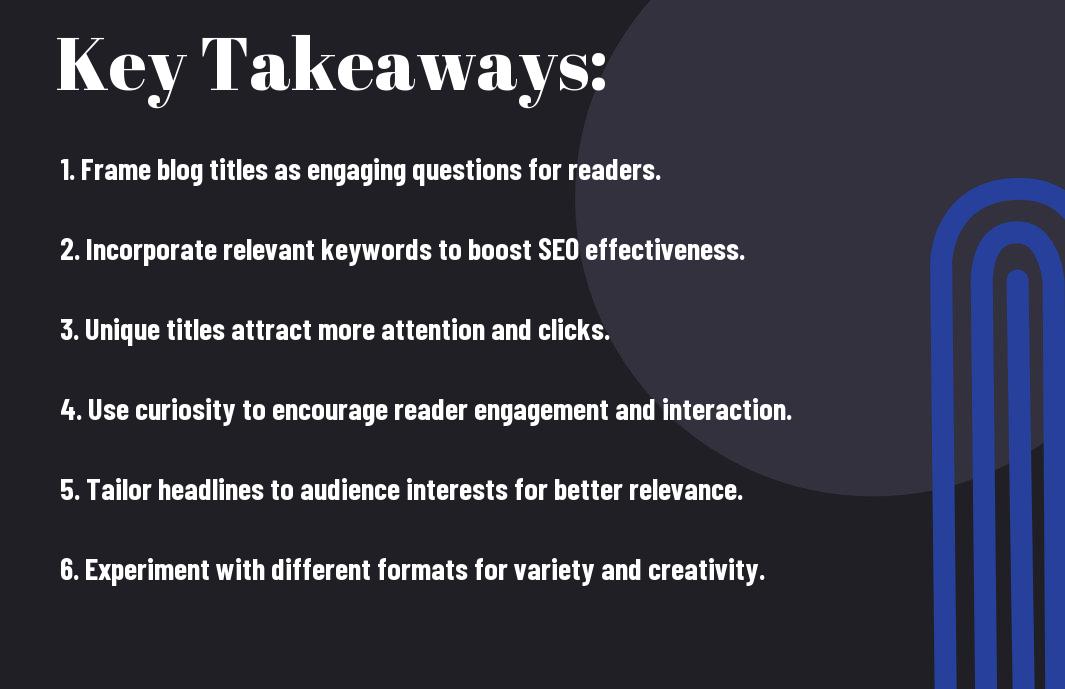It’s important to capture your audience’s attention with compelling blog headlines that spark curiosity. In this post, you’ll discover ten unique blog headline titles framed as questions, specifically designed to incorporate the keywords you’ve provided. By aligning your content with these intriguing headlines, you can effectively engage your readers and encourage them to explore your posts further. Join us as we probe these creative options that can transform your blogging strategy!
Key Takeaways:
- Engagement: Framing blog headlines as questions can significantly increase reader engagement by sparking curiosity.
- Relevance: Incorporating keywords ensures that the headlines stay relevant to the target audience, making the content more discoverable.
- Diversity: Utilizing a variety of unique question formats in headlines can cater to different reader preferences and enhance overall appeal.

Can I Boost Conversion?
Your ability to boost conversion rates is a vital aspect of online success. It revolves around understanding your audience and implementing strategies tailored to their preferences and behaviors. By effectively enhancing user experiences and engagement on your site, you can significantly increase the likelihood of visitors taking desired actions, whether that’s signing up for a newsletter, making a purchase, or downloading a resource. So, how can you accomplish this goal?
With Effective CTAs
While a well-placed call to action (CTA) can be the difference between a visitor leaving your site and becoming a customer, it’s crucial to craft CTAs that resonate with your audience. You want your CTAs to be clear, compelling, and action-oriented. Phrasing matters; using phrases like “Get Started,” “Join Us,” or “Claim Your Offer” creates a sense of urgency. Furthermore, positioning these CTAs strategically throughout your site can guide your visitors seamlessly through the customer journey, making it more likely that they will convert.
By Optimizing Landing Pages
If you’re looking to boost conversion rates, optimizing your landing pages is crucial. This means ensuring that each landing page you create is focused specifically on a single goal—whether that’s gathering leads, selling a product, or promoting a webinar. The elements on the page should be designed to eliminate distractions and reinforce your message, guiding your visitors toward taking the desired action.
With strategic use of headlines, subheadings, and bullet points, you can highlight the benefits you offer and make the information digestible. Additionally, including clear, engaging visuals and testimonials can boost credibility and enhance emotional appeal, further encouraging visitors to follow through with the action you want them to take. By focusing on these elements, you position your landing pages as powerful tools for converting traffic into actionable results.
How Do I Increase?
While many bloggers and website owners often wonder how to increase their website traffic quickly, the answer lies in a blend of strategic promotion and smart content development. You need to focus on leveraging search engine optimization (SEO), social media marketing, and email campaigns to reach your target audience effectively. You’ll find that implementing a cohesive strategy can significantly boost your online visibility and attract more visitors to your site in a shorter time frame.
Website Traffic Quickly
Clearly, one of the most immediate methods to increase your website traffic is through effective SEO practices. Focusing on keyword research, improving your meta descriptions, and utilizing header tags can make a notable difference. Additionally, consider creating high-quality backlinks, as they establish your site’s authority and drive referral traffic. Engaging with online communities relevant to your niche can also lead to more visitors, as you actively share your content with those who have a vested interest in it.
Engaging Content Strategies
For sustainable growth in your website traffic, you need to prioritize engaging content strategies. This means understanding what resonates with your audience and consistently delivering compelling, informative, and entertaining content that aligns with their interests. By harnessing the power of storytelling, visual media, and interactive elements, you can create a more immersive and enjoyable experience that encourages visitors to stay longer and return often. Ensure that your content is easily digestible and shareable to amplify its reach across various platforms.
This continuous engagement with your audience will not only enhance your traffic but also build a loyal community around your brand. Implementing strategies such as regular blog updates, leveraging social media platforms, or even creating podcasts and videos can diversify your content offering. Be mindful of, the goal is to keep your audience engaged and eager for more, making them more likely to share your content and recommend your site to others. As you incorporate these strategies, watch as your website traffic begins to increase significantly over time.
What Are Best SEO?
Unlike many misconceptions, the best SEO (Search Engine Optimization) practices are not solely about tricking search engines. Instead, they focus on creating a user-friendly experience that enhances the relevance of your content and ensures that users find what they are looking for efficiently. This means understanding your audience, structuring your content effectively, and implementing strategic keywords throughout your site. By adhering to these best practices, you can improve your visibility in search engine results, thereby attracting more organic traffic to your site.
Practices For Beginners
Any beginner venturing into the world of SEO should start with comprehensive keyword research. This fundamental practice allows you to discover the terms and phrases that your target audience is using to search for information, products, or services related to your niche. Begin by brainstorming potential keywords and using tools to find their search volume, competition levels, and relevance to your content. Once you have identified a solid list of keywords, integrate them naturally into your content, including titles, headers, and throughout the body of your articles. This will not only help improve your rankings but will also enhance user experience by ensuring that your content addresses the needs and queries of your audience.
Tools For Keyword Research
Practices for keyword research involve leveraging various tools to uncover the best keywords that will drive traffic to your site. Several popular tools, such as Google Keyword Planner, Ahrefs, and SEMrush, provide valuable insights into what your competitors are ranking for, alongside metrics like search volume and keyword difficulty. By analyzing these factors, you can prioritize which keywords to target in your SEO strategy, ensuring that you’re focusing on the most beneficial opportunities available to you. Incorporating these tools into your regular SEO routine will not only streamline your efforts but also keep you informed about any shifts in trending keywords relevant to your audience.
Plus, staying updated with keyword trends is crucial in a constantly evolving digital landscape. Many tools, such as Moz’s Keyword Explorer and Ubersuggest, provide ongoing updates, allowing you to refine your strategy in real time. By continually analyzing keyword performance, you can adapt your content and boost your chances of ranking higher in search engine results, ensuring your audience can easily find your content and engage with your offerings.
Do I Need Social?
After contemplating the importance of your online presence, you may find yourself asking whether social media is truly necessary for your brand. In today’s digital landscape, having a robust social strategy can elevate your visibility and foster deeper engagement with your audience. With billions of users actively interacting on social platforms, skipping out on social media could mean missing significant opportunities to connect with potential customers and build relationships that translate into long-term loyalty.
Media Marketing Strategy
You’ll want to think of social media as a pivotal component of your media marketing strategy. It serves not only as a channel for promoting your products and services but also as a medium for storytelling that lets you express your brand’s values and personality. By leveraging social media, you can reach a diverse audience, gather insights about their preferences, and tailor your offerings to meet their specific needs. Ignoring this powerful tool could hinder your growth and limit your reach in an increasingly competitive market.
Influencer Partnerships Today
Today, influencer partnerships are at the forefront of effective marketing strategies. As you consider integrating social media into your marketing plan, influencers can help you amplify your message and extend your reach to niche audiences who trust their recommendations. Collaborating with influencers not only enhances your brand’s credibility but also offers a more personal touch, making your marketing efforts resonate on a deeper level.
Needless to say, choosing the right influencers can significantly impact your brand’s image and success. With the right partnerships, you can tap into established communities and engage your target audience in a manner that is authentic and meaningful. Thus, understanding the dynamics of influencer partnerships today could be pivotal in establishing your brand as a leader in your niche.
Can AI Improve My?
All businesses today are exploring ways to leverage artificial intelligence (AI) to enhance their operations. This includes innovations in streamlining the content creation process which is crucial for effective communication and marketing strategies. AI can assist you in generating ideas, drafting articles, and refining your writing to engage your audience more effectively. With the integration of AI tools, you can significantly reduce the time required for the content creation process, allowing you to focus on high-level strategy and creativity.
Content Creation Process
Process automation through AI can elevate your content creation by providing instant insights and suggestions based on current trends and audience preferences. By analyzing existing data, AI algorithms help you generate relevant topics and optimize your content for search engines, potentially increasing your visibility and reach. Additionally, AI-powered writing assistants can help you maintain a consistent tone and style across various platforms, ensuring that your brand voice remains strong.
Customer Service Experience
Some businesses are utilizing AI to transform their customer service experience. AI chatbots and virtual assistants can handle inquiries efficiently, providing immediate responses to customer questions. This allows you to offer 24/7 support and ensures that customers feel valued and attended to, even outside normal business hours. Furthermore, by analyzing patterns in customer interactions, AI can help you identify common pain points and improve your services accordingly.
Customer engagement improves exponentially when AI is integrated into your customer service strategy. Along with offering quick solutions to frequent queries, AI can gather feedback and learn from customer interactions, leading to better service offerings over time. You can leverage this data to personalize interactions and build stronger relationships with your customers, ultimately fostering loyalty and enhancing their overall experience with your brand.

How Often Should I?
Not knowing how often to engage with your online audience can lead to missed opportunities and reduced visibility. Striking the right balance is crucial for building and maintaining a strong online presence. Whether it’s posting on social media or updating your website content, understanding the optimal frequency can greatly enhance your engagement and effectiveness.
Post On Social Media
Little consistency in your social media posting can result in decreased engagement levels. Ideally, you should aim to post at least 3-5 times per week across your platforms, adapting to the specific audience and platform requirements. For instance, you might want to post daily on Instagram while increasing frequency on Twitter due to its fast-paced nature. Monitoring your posts can help you discover when your audience is most active, allowing you to fine-tune your posting schedule for maximum impact.
Update My Website Content
Media outlets and search engines thrive on fresh, relevant content. Therefore, it’s vital to update your website content regularly to keep both your audience and your SEO rankings satisfied. A good practice is to refresh your main content at least every 3-6 months and add new articles or blog posts weekly or bi-weekly. This upkeep not only keeps your site relevant but also establishes you as an authority in your field.
Update your website by incorporating new information, optimizing old blog posts, or even changing outdated graphics. This approach not only provides value to your visitors but also reflects your commitment to delivering quality content. Engaging in regular updates can help you improve your site’s overall performance, encouraging return visits and increasing the likelihood of higher search engine rankings, making your site more visible to potential clients or customers.
What Is The Role?
To understand the significance of storytelling in marketing, you must first recognize its ability to create a narrative that resonates with your audience. Stories engage consumers on a deeper level, enabling them to connect with your brand beyond mere transactional relationships. When you weave a compelling narrative into your marketing strategy, you not only capture attention but also foster brand loyalty. This emotional engagement can lead to higher conversion rates, as consumers are more likely to purchase from a brand they feel connected to.
Of Storytelling In Marketing
Any marketing campaign that incorporates storytelling can effectively differentiate your brand in a crowded marketplace. By using narratives that reflect your brand values and consumer experiences, you have the opportunity to create memorable campaigns that leave a lasting impression. Your audience will perceive your marketing efforts as more relatable and authentic, which is crucial in building trust. As you craft stories that highlight how your products or services impact real lives, you position your brand as a solution to their problems, reinforcing your place in their decision-making process.
Of Emotional Connections Online
Little do most marketers realize the profound impact that emotional connections can have on online consumer behavior. You have the unique opportunity to evoke emotions through digital storytelling, whether it’s through videos, blog posts, or social media updates. When your content resonates emotionally, it encourages sharing and engagement, increasing your visibility and reach. By tapping into feelings such as joy, nostalgia, or even empathy, you create a bond with your audience that makes them more inclined to support your brand, advocate for it, and remain loyal over time.
Plus, understanding the importance of emotional connections online allows you to craft your messaging in a way that reflects your audience’s aspirations and struggles. By identifying what matters most to them, you can create content that resonates on a personal level, making your brand not just a product, but a part of their story. In a world where consumers are bombarded with options, recognizing the role of emotions can be the difference between standing out and blending in.
How Do I Measure?
Now that you’ve commenceed on your digital marketing journey, it’s crucial to understand how to measure your efforts effectively. Measurement is more than just tracking numbers; it’s about gaining insights that drive better decision-making. By evaluating your data, you can refine your strategies and increase your overall marketing efficacy. You need to know what metrics you should be focusing on to assess your campaigns accurately. This might include analyzing traffic sources, conversion rates, and engagement levels to get the full picture of your success.
Success Of My Campaign
Even successful campaigns should undergo thorough evaluation. Have you ever found yourself wondering whether the resources you invested were worth it? Tracking metrics such as click-through rates, customer feedback, and lead generation can provide you with concrete evidence of your campaign’s impact. The goal is to compare the results against the objectives you set at the beginning. If certain aspects of your campaign outperformed others, consider reallocating resources to capitalize on those areas. This way, you create a continuous cycle of improvement.
ROI Of Digital Marketing
Clearly, return on investment (ROI) is a critical metric that gauges the effectiveness of your digital marketing efforts. It allows you to determine whether your digital marketing activities are truly driving financial gains. To calculate ROI, you can utilize the formula: (Net Profit / Cost of Investment) x 100. Knowing your ROI enables you to make informed decisions that align with your business goals. Analyzing your digital marketing ROI helps you identify which campaigns deliver the most value and where adjustments are needed to enhance your overall performance.
Measure your ROI consistently to stay on top of your marketing effectiveness. By examining metrics like customer acquisition costs and lifetime value, you can gain deeper insights into the overall health of your marketing strategies. Regular calculations allow for real-time adjustments so you can either double down on successful channels or revise your approaches that aren’t performing as expected. Keeping a close eye on these numbers will empower you to optimize your efforts and realize a stronger ROI over time.
What Is The Future?
Keep in mind that the future holds many possibilities, especially in the landscape of digital marketing. As technology evolves, so do the trends that shape how businesses engage their audiences. You can expect to see increased personalization, where data analytics helps craft tailored experiences that resonate with individual consumers. For you, this means understanding your target market more deeply than ever and leveraging insights for effective marketing strategies. Emerging platforms and technologies will continue to transform how content is created and consumed, pushing you to adapt your messaging and outreach efforts to remain relevant.
Of Digital Marketing Trends
Assuming you have an interest in digital marketing, the future of this field looks incredibly promising yet challenging. One of the major trends you should keep an eye on is the rise of immersive technologies such as augmented reality (AR) and virtual reality (VR). These technologies not only enhance customer engagement but also create memorable experiences that resonate with your audience. By integrating these tools into your marketing strategies, you can offer consumers an interactive perspective that showcases products or services in an entirely new light, potentially increasing conversion rates and brand loyalty.
Of Artificial Intelligence Tools
There’s no denying that artificial intelligence (AI) will play an imperative role in the future of marketing. As these tools become more sophisticated, they will enable you to automate repetitive tasks and analyze vast amounts of data quickly. Whether it’s using chatbots for customer service or employing machine learning algorithms to refine your targeting strategies, AI will significantly enhance your ability to make informed decisions. Embracing AI will not only save you time but also improve efficiency, allowing you to focus your energy on creative and strategic areas of your business.
You can look forward to advancements in AI tools specifically designed to help marketers optimize their campaigns. With features like predictive analytics, natural language processing, and automated content generation, your ability to connect with consumers will become even more refined. As these technologies continue to evolve, the landscape of digital marketing will transform, creating opportunities for you to innovate and succeed in ways you may not have previously imagined. Keeping abreast of these developments will be crucial to your long-term strategy.
Final Words
Considering all points, you can see how effective blog headlines framed as questions can significantly enhance your content’s engagement and draw in your audience. By incorporating the specific keywords that are vital to your niche, you not only improve your SEO but also directly address the interests and queries of your potential readers. This targeted approach ensures that your blog stands out amidst the vast digital landscape, enticing readers to click and explore what you have to offer.
Additionally, using questions as blog titles encourages interaction and curiosity, prompting your audience to think and reflect on the subject matter. Remember to keep your headlines clear and creative, ensuring they resonate with your intended message. By implementing these strategies, you are well on your way to crafting compelling content that captivates and retains your audience, ultimately elevating your blogging journey.
FAQ
Q: What are some tips for creating unique blog headline titles?
A: To create unique blog headline titles, consider incorporating engaging adjectives, using numbers for listicles, asking intriguing questions, addressing the reader directly, and including keywords relevant to the content of your blog. This combination helps capture the interest of your audience while ensuring that your content is easily discoverable through search engines.
Q: How do I make sure my blog headlines are SEO-friendly?
A: To make your blog headlines SEO-friendly, include your target keywords, keep titles between 50-60 characters for optimal display in search results, and ensure they are both descriptive and engaging. Additionally, using action verbs can motivate readers to click on your link, which can improve your blog’s visibility in search results.
Q: Why is it important to frame blog titles as questions?
A: Framing blog titles as questions can pique curiosity and encourage readers to seek answers. It creates an invitation for readers to explore the content to find solutions to their inquiries. This approach often leads to higher engagement rates, as readers are more likely to click on titles that resonate with their concerns or interests.
Q: Can you provide an example of a unique blog headline framed as a question?
A: Certainly! An example could be “What Are the Top 10 Life Hacks for Boosting Productivity?” This title includes a number and a question format, making it appealing and informational, which attracts readers seeking valuable tips.
Q: How often should I update my blog headlines to keep them fresh?
A: It’s a good practice to periodically review and update your blog headlines, especially for older posts. Consider revising titles every 6-12 months to ensure they remain relevant, incorporate current keywords, or enhance engagement. Updating titles not only attracts new readers but can also improve search engine rankings.


